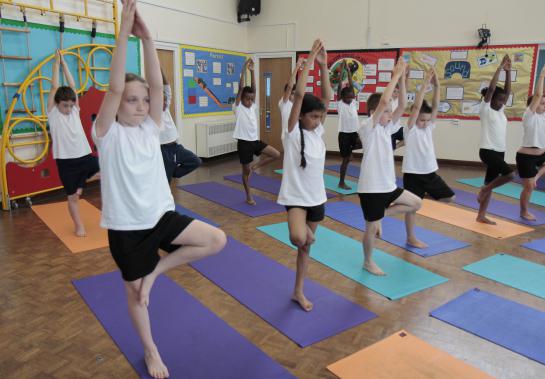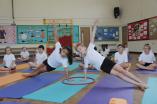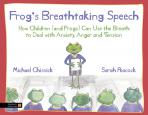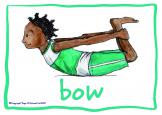Bear Hunt in the Yoga Lesson


Introduction
I often use established and favourite stories in my yoga lessons. I find that some stories are well suited to the embedding of the postures . We're Going on a Bear Hunt written by Michael Rosen and illustrated by Helen Oxenbury, one of the most popular children's books ever, falls into that category. In this article I will share how I used Bear Hunt with Years 1, 2 and 3 to help the children to deepen their experience of the richness of the words and improve their acting skills; as well as improving their balancing, focus and concentration.
Aims
- To encourage the children to invent actions to match Rosen's wonderfully onomatopoeic wordslike Swishy Swashy and Splash Splosh
- To improve aspects of their tree posture, balancing and concentration skills.
- To improve children's ability to focus on an object
Method
My yoga lessons involve the whole class and take place in the school hall, which is an advantage because you need plenty of space for this activity. You do not need any yoga expertise for this activity, it is safe and, as you will see, is great fun. I have broken it down in to digestible stages for you.
Stage 1: Teach the children the Sneaky Trees Game
Sneaky Trees is game based on the old favourite Grandma's Footsteps. The children stand in a straight 
 line near to the wall on one side of the hall, shoulder to shoulder, in a posture called Stick (Mountain Posture for yoga aficionados). Stick posture is about standing still quietly and listening.
line near to the wall on one side of the hall, shoulder to shoulder, in a posture called Stick (Mountain Posture for yoga aficionados). Stick posture is about standing still quietly and listening.

 line near to the wall on one side of the hall, shoulder to shoulder, in a posture called Stick (Mountain Posture for yoga aficionados). Stick posture is about standing still quietly and listening.
line near to the wall on one side of the hall, shoulder to shoulder, in a posture called Stick (Mountain Posture for yoga aficionados). Stick posture is about standing still quietly and listening.I would stand in the middle of the hall with my back towards them. On the signal Go! the children walk towards me until I spin round and shout Sneaky Trees! Whereupon they came to halt and stand in Tree Posture. Now that they are in the posture I encourage then to work on the following aspects:
- Tree feet
- Stretching their arms up
- Focusing
To help them I would have placed interesting objects e.g. animal shapes placed at different levels on the wall that the children are facing. They choose which objects to focus upon. To ensure that they are focusing I would ask random children what they are focusing on.
They love this game and I suggest that you play it for several weeks before moving on to the next stage. Each time you play encourage the children to improve the three aspects of the posture. I will often reward a specific aspect, for example, good focusing, or excellent Tree Feet.
Stage 2: Using Bear Hunt within the Sneaky Trees Game
Simply follow the same procedure for Sneaky Trees. As they stand in line in Stick ask them to imagine a field of long wavy grass in front of them. Ask them to imagine the grass swaying in the wind making the sound Swishy Swashy, Swishy Swashy, Swishy Swashy. At this point you say to them:
"We can't go over itWe can't go under it"
"Oh no!We've got to go through it!"
Their task is to show you how they walk through this field of long wavy grass, while repeating Swishy Swashy loudly in an interesting way. At some point shout Sneaky Trees! The children will need to come to halt and come into Tree Posture quietly and calmly. Again you will encourage them to work on the three aspects of Tree Feet, Stretching-Up and Focusing.
When you are ready, ask the children to go back to the start and repeat the activity. This time you ask them to imagine that the area in front of them is a river, a deep cold river. Of course stressing that you are only pretending! Their task now is to show you how they cross the river repeating Splash Splosh! Splash Splosh! Splash Splosh! in an interesting way. By now all of you would have said the mantra:
"We can't go over itWe can't go under itOh no!We've got to go through it!"
Having set the structure or pattern of the activity you can simple follow the sequence of the book. My two favourite sections are Mud, Thick, Oozy Mud and a Snowstorm, a Swirling Whirling Snowstorm. The former because I lost count how many wellies got stuck and had to be left behind; and the latter because everyone loved hugging their coats to themselves as they battled headlong into the gusty winds.
I suggest that you only attempt three parts in each session. In other words
Session 1: Grass, River, MudSession 2: Forest, Snowstorm, Cave IT'S A BEAR!Session 3: IT'S A BEAR! Back through the cave, back through the snowstorm and so on.
I admit that the return journey, getting back into the house, upstairs and under the bed covers is slightly chaotic, but I know your outstanding classroom management skills will see you through. Besides, "under the bed covers is a great way into relaxation.
Summary
I dedicated five weeks (a half term) to this activity and can report that the children were highly motivated, exceptionally creative and went about their work with total enthusiasm. Also most of the children knew the story and those that didn't were turned on to it. I am convinced it worked well because most children knew the story, that the game was simple and fun and that the children were challenged to improve their posture
The rewards, praise and encouragement for Tree Feet, Stretching Up and Improved Focus had a powerful effect on improving those aspects across the board
Interested in becoming a Yoga Trained School ? Simply complete the form and I'll get back to you
(c) Copyright 2017 Michael Chissick & Yoga at School.Not to be reproduced or distributed without permission






